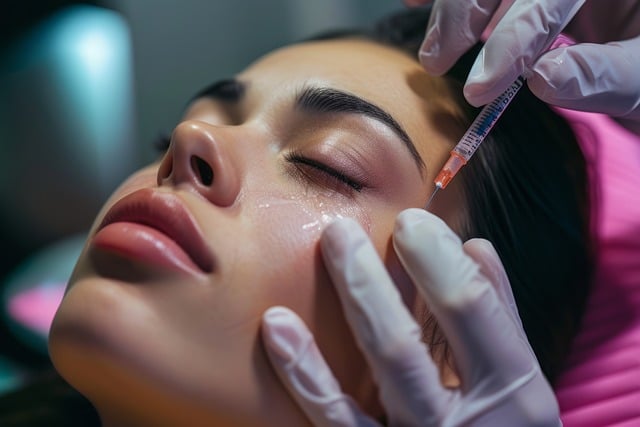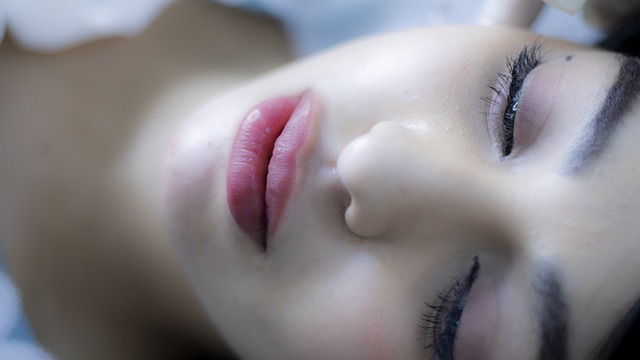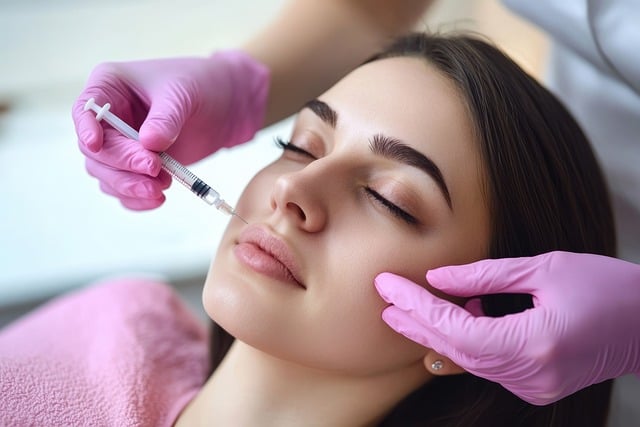Botox for facial contouring is a non-invasive procedure using botulinum toxin to relax overdeveloped muscles, particularly in the jawline. It offers a safe and effective way to achieve a slimmer, more defined look with minimal downtime. Results typically appear within 24-72 hours and last 3-6 months, making it a cost-effective alternative to surgery. However, it carries risks like muscle weakness or uneven results, so consulting a qualified medical professional is crucial before treatment. Choose a reputable clinic for optimal safety and effectiveness.
What is Botox? An Overview

Botox is a natural protein produced by bacteria that, when injected into specific muscles in the face, can temporarily paralyze or weaken them. This safe and effective treatment has gained popularity for facial contouring, including jawline tightening. By relaxing the masseter muscle, which is responsible for chewing and is often overdeveloped in individuals with a square jawline, Botox can create a slimmer and more defined look without surgery. The procedure involves precise injections to achieve desired results while minimizing downtime, making it an attractive non-invasive option for those seeking facial aesthetic enhancements.
The Science Behind Botox for Facial Contouring

The science behind Botox for facial contouring involves the strategic injection of botulinum toxin into specific muscle groups. This neurotoxin temporarily paralyzes muscles, reducing their ability to contract and relax. When applied to the jawline, Botox can smooth out jutting angles and define contours, creating a more streamlined and sculpted appearance. The procedure is non-surgical and minimally invasive, making it a popular choice for those seeking subtle yet effective facial enhancements.
How Botox Can Tighten Your Jawline

Botox for facial contouring has emerged as a popular non-surgical procedure for jawline tightening. By relaxing the muscles responsible for jaw tension and masseter hyperactivity, Botox can reduce the appearance of a saggy or flabby jawline. This treatment involves injecting a small amount of Botox into specific muscle groups around the jaw, which over time, leads to a more defined and sculpted look. The procedure is minimally invasive, with little to no recovery time, making it an appealing option for individuals seeking a non-surgical alternative to surgical face lifts or jawline contouring procedures.
The effects of Botox are not immediate; it typically takes 24 to 72 hours to kick in, and the full result may take up to a week to become apparent. The results of Botox for jawline tightening can last anywhere from 3 to 6 months, after which time a touch-up treatment may be necessary to maintain the desired contouring effect. This longevity makes it a cost-effective solution for those looking to enhance their facial structure without the need for repeated surgeries.
Benefits of Using Botox for Jawline Tightening

Botox for facial contouring has emerged as a popular non-surgical procedure for jawline tightening. One of the key benefits is its ability to offer a temporary yet significant improvement in facial structure without any recovery time. By relaxing the muscles responsible for jutting or squaring jawlines, Botox can create a more defined and sculpted look that many find aesthetically pleasing.
Furthermore, this treatment provides a minimally invasive approach to achieving a desired facial contour. Unlike surgical procedures, which carry risks and potential complications, Botox is generally safe and well-tolerated by most patients. It allows individuals to correct facial asymmetries or achieve a more balanced appearance without undergoing extensive surgery. The results are gradual, typically taking 2-4 days to appear, and can last for several months, making it an appealing option for those seeking subtle yet effective jawline tightening.
Potential Risks and Side Effects to Consider

While Botox for facial contouring, particularly on the jawline, has proven effective in reducing jowls and improving facial definition, it’s crucial to be aware of potential risks and side effects. Not everyone is a suitable candidate for this procedure, and individual results may vary. Temporary muscle weakness or paralysis is a common side effect, which can impact facial expressions temporarily. In rare cases, asymmetry or an uneven jawline can result if not administered correctly. Additionally, some individuals may experience headaches, swelling, bruising, or discomfort at the injection sites. It’s essential to consult with a qualified medical professional who can assess your specific needs and discuss these potential risks in detail before proceeding with any cosmetic treatment.
The Procedure: Step-by-Step Guide

The procedure for Botox for facial contouring, specifically targeting the jawline tightening, involves a series of precise steps. 1. A qualified healthcare provider will conduct an initial consultation to assess your facial structure and determine if Botox is suitable for you. 2. During the treatment session, tiny injections of Botox are administered along the jawline and masseter muscles, carefully targeting areas where facial tension and bulk contribute to a loose or sagging appearance.
3. The procedure is usually quick, taking only about 15-30 minutes, depending on the extent of treatment required. 4. After the injections, minimal downtime is needed; you may experience mild temporary redness or swelling but these usually subside within a few days. 5. Results typically start to become visible within 2-4 weeks as the Botox relaxes the muscles, leading to a tighter and more defined jawline and improved facial contouring.
Recovery Time and What to Expect

After the Botox for facial contouring procedure, most individuals can resume their regular activities within a few days. However, it’s crucial to expect some temporary redness and swelling around the treatment areas, which typically subside within 24-48 hours. During this recovery period, you may feel mild discomfort or sensitivity, but these symptoms are usually manageable without over-the-counter pain relievers.
It is important to follow your healthcare provider’s aftercare instructions carefully, including keeping the treated area clean and avoiding strenuous activities or extreme temperatures for a brief period. You’ll likely notice results starting to take shape within 2-4 weeks, with optimal tightening effects reached around 6-12 weeks post-treatment. Remember that Botox is a natural, temporary solution, so repeat treatments will be necessary for sustained results.
Choosing the Right Clinic and Professional

When considering Botox for facial contouring, particularly for jawline tightening, choosing the right clinic and professional is paramount. Look for a reputable facility with experienced, certified practitioners who specialize in aesthetic procedures. Ensure they have a proven track record of successful jawline tightening treatments, positive client testimonials, and up-to-date knowledge on the latest Botox techniques and safety protocols.
Inquiring about certifications, insurance coverage, and aftercare instructions is essential before scheduling any procedure. A good clinic will offer comprehensive consultations to assess your specific needs, provide realistic expectations, and address any concerns you may have. They should also be equipped with state-of-the-art equipment and sterile environments to ensure a safe and effective Botox for facial contouring experience.
Conclusion: Is Botox Right for You?

Botox for facial contouring, particularly when targeted at the jawline, can offer a non-invasive and effective solution for those seeking to enhance their facial features. Before deciding if this procedure is right for you, there are several factors to consider. The suitability of Botox depends on your individual goals, skin type, and overall health. It’s essential to discuss these with a qualified healthcare professional who can provide personalized advice based on your unique needs.
Botox has been proven effective in reducing the appearance of jowls and slackening facial muscles that contribute to a sagging jawline. However, it may not be suitable for everyone, as results can vary based on age, muscle mass, and skin elasticity. Additionally, maintaining results requires regular treatments, which can be a financial commitment. Therefore, careful consideration is necessary to ensure it aligns with your desired outcomes and long-term satisfaction.
